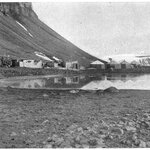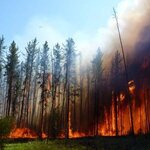Environment

The Arctic's Warming Islands
In 2005, as Greenland's glacier cover receded due to global warming, what had formerly been known as a cape was shown to be an island. It made headlines. On the west coast of Northbrook island in Franz Joseph Land lies Cape Flora. It was there that Fridtjof Nansen was greeted by Frederick George Jackson after Nansen's 'Furthest North' trek. It was there also that Benjamin Leigh Smith was shipwrecked in 1881. In 1980 it was discovered by Russian explorers following major ice retreat since the 19th century that Cape Flora is in fact an…

The Environmental Working Group (EWG) says that it "helps protect your family from pesticides."
The purpose of this Applied Mythology post is to "help protect your family from dangerously misleading information from the EWG."
Each year since 1991, the USDA has been publishing the results from a large-scale pesticide residue monitoring program called the PDP. Each year, a different set of crops is chosen and samples are purchased from regular stores and tested. Year after year, the results of those studies confirm the safety of the food supply. Year after year the EWG…

The movement of nitrate through groundwater to streams can take decades to occur and that long lag time means that changes in the use of nitrogen-based fertilizer (the typical source of nitrate) may take decades to be fully observed in streams, according to a recent study.
Water quality experts have been noting in recent years that nitrate trends in streams and rivers do not match their expectations based on reduced regional use of nitrogen-based fertilizer. The long travel times of groundwater discharge, like those documented in this study, have previously been suggested as the likely…

During the late Pleistocene, which ended about 12,000 years ago, a remarkably diverse assemblage of large-bodied mammals inhabited the "mammoth steppe," a cold and dry environment that extended from western Europe through northern Asia and across the Bering land bridge to the Yukon.
Of the large predators - wolves, bears, and big cats - only the wolves and bears were able to maintain their ranges well after the end of the last ice age and a new study suggests that dietary flexibility may have been an important factor giving wolves and bears an edge over saber-toothed cats and cave lions.…

Contrary to widespread consumer belief, organic farming is not the best way to farm from an environmental point if view.
The guiding principal of organic is to rely exclusively on natural inputs. That was decided early in the 20th century, decades before before the scientific disciplines of toxicology, environmental studies and climate science emerged to inform our understanding of how farming practices impact the environment.
As both farming and science have progressed, there are now several cutting edge agricultural practices which are good for the…

Wildfires turn millions of hectares of vegetation into charcoal each year but it wouldn't seem like it ends up in the oceans.
Yet researchers have found that this charcoal does not remain in the soil, as previously thought. Instead, it is transported to the sea by rivers and thus enters the carbon cycle. The researchers analyzed water samples from all over the world. They demonstrated that soluble charcoal accounts for ten percent of the total amount of dissolved organic carbon.
Researchers collected 174 water samples from all over the world, including rivers like the Amazon, the…

Some of the world's best coffee comes from the tropical highlands of Central and South America. Recently these regions have experienced heavier rainfall. This is probably due to climate change, but in any case it fosters severe epidemics of the Coffee Leaf Rust pathogen, Hemileia vastatrix. This disease has a long history of disrupting coffee production around the world. One reason the English drink tea is that the Ceylonese and Javan coffee plantations which once supplied them were devastated by this same fungus in the late 1800s. Coffee production…

The world produces a lot of food, enough to feed billions more than are living right now. There is a distribution issue, which will be solved as science engineers more crops that can grow in more local conditions, but one way to make more food available right now will also save people money - reducing food waste.
4 out of every 10 pounds produced in the United States alone goes to waste, claimed John Floros, Ph.D., dean of the College of Agriculture at Kansas State University, in a keynote talk at the American Chemical Society meeting.
Government estimates are that…

If there is a contentious and politicized branch of science today it is climate science. Either it's global warming, or global cooling, but we have settled on climate change, just in case it goes in a direction that is opposite to our predictions (beliefs?). I am not a specialist. So I can't weigh in and let you know who is right. But, it seems that the specialists are also at a loss to explain what is going on and what will happen with any degree of certainty. This is an excellent article:
http://www.economist.com/news/science-and-technology/21574461-climate-ma...
It appears to summarize…
Globally existential threats due to ‘overpopulation momentum’ together with the top-heavy age structure leave by now no alternative to radical technological adaptation for anything that wants to survive 'long term'. It is strictly too late to ‘go green’ except via a novel take on what constitutes ‘green’, including synthetic biology. Hyped for a long time, nanoscience is still largely in its pioneering phase. However, it matures as we speak and soon, as it becomes true nanotechnology, it will leave the hype far behind.
Is nanotech harmless? Mother Nature has…